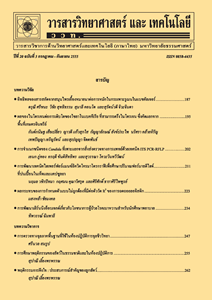ระบบปรับอากาศชนิดดูดซึมใช้พลังงานแสงอาทิตย์สำหรับอาคาร
Main Article Content
Abstract
บทคัดย่อ
คู่มือข้อมูลมาตรฐานด้านภูมิอากาศและแสงอาทิตย์สำหรับใช้งานด้านพลังงานทดแทน ของกรมพัฒนาพลังงานทดแทนและอนุรักษ์พลังงาน ปี พ.ศ. 2548 แสดงว่าประเทศไทยได้รับพลังงานแสงอาทิตย์ต่อวันประมาณ 18.2 MJ/m2-day จึงมีศักยภาพที่จะใช้ประโยชน์จากพลังงานแสงอาทิตย์ในรูปของความร้อนได้เป็นอย่างดี การใช้แผงผลิตน้ำร้อนพลังงานแสงอาทิตย์สะสมและส่งน้ำร้อนไปแยกสารทำความเย็นออกจากสารละลายตัวกลางในการทำความเย็นแบบดูดซึม (absorption refrigeration) เป็นเทคโนโลยีการทำความเย็นเพื่อการปรับอากาศด้วยพลังงานแสงอาทิตย์เทคโนโลยีใหม่ที่ได้รับการพัฒนาในช่วงทศวรรษที่ผ่านมาและกำลังเผยแพร่เชิงพาณิชย์ในประเทศตะวันตกและจีน โดยมีเป้าหมายทดแทนเครื่องปรับอากาศพลังงานไฟฟ้า ในปัจจุบันประเทศไทยมีการใช้งานระบบทำความเย็นแบบดูดซึมขนาดใหญ่ที่ใช้พลังงานความร้อนทิ้งจากกระบวนการอุตสาหกรรมและจากการผลิตไฟฟ้า ยังไม่พบการนำพลังงานแสงอาทิตย์ที่เป็นแหล่งพลังงานทดแทนมาใช้ในการทำความเย็นและการปรับอากาศในอาคาร การสำรวจพบว่าคนไทยต้องอาศัยการปรับอากาศเพิ่มขึ้นและใช้น้ำร้อนเพิ่มขึ้น รายงานการศึกษาโดยสำนักงานคณะกรรมการนโยบายวิทยาศาสตร์ เทคโนโลยีและนวัตกรรมแห่งชาติ (สวทน.) ปี พ.ศ. 2553 พบว่ามีการใช้แผงผลิตน้ำร้อนพลังงานแสงอาทิตย์ที่นำเข้าและที่ผลิตในประเทศจำนวนกว่า 100,000 ตารางเมตร ในครัวเรือนและในอาคารสาธารณะ การใช้พลังงานแสงอาทิตย์มาผลิตน้ำร้อนและการปรับอากาศเป็นอีกทางเลือกหนึ่งที่สำคัญต่อความมั่นคงด้านพลังงานของประเทศ การลดก๊าซเรือนกระจกจากการใช้เชื้อเพลิงฟอสซิล และการลดค่าใช้จ่ายด้านพลังงาน
คำสำคัญ : แผงรับพลังงานแสงอาทิตย์; น้ำร้อนพลังงานแสงอาทิตย์; การทำความเย็นพลังงานแสงอาทิตย์; เครื่องทำน้ำเย็นระบบดูดซึม
Abstract
Handbook of Solar Radiation and Climatic Data for Renewable Energy Application by Department of Alternative Energy Development and Efficiency in 2005 shows that solar radiation in Thailand is around 18 MJ/ m2-day, showing high potential in solar thermal application. The application of solar water heater to produce hot water for separating the refrigerant from the medium solution in the absorption refrigeration is a new refrigeration technology for air conditioning in this decade. It is now commercially distributed among the western countries and China, with the purpose of replacement of the electrical air conditioner. Currently, Thailand uses large absorption system utilizing waste heat from industry and electricity generation. Solar energy for refrigeration and air conditioning for buildings are not found in Thailand despite its renewable energy source. Exploration shows Thai people increasingly depends on air conditioning and uses more hot water. The report of National Science Technology and Innovation Policy Office in 2010 shows that the use of local and imported solar water heater in households and public buildings in year 2008 are 100,000 square meter. Solar water heater for hot water and for air conditioning is an important choice for the energy security, the decrease of greenhouse gas emission and the reduction of energy expense.
Keywords: solar collector; solar water heater; solar assisted cooling; absorption chiller


